Related Research Articles
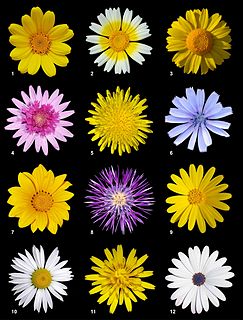
The family Asteraceae, alternatively Compositae, consists of over 32,000 known species of flowering plants in over 1,900 genera within the order Asterales. Commonly referred to as the aster, daisy, composite, or sunflower family, Compositae were first described in 1740. The number of species in Asteraceae is rivaled only by the Orchidaceae, and which is the larger family is unclear as the quantity of extant species in each family is unknown.

Petals are modified leaves that surround the reproductive parts of flowers. They are often brightly colored or unusually shaped to attract pollinators. Together, all of the petals of a flower are called corolla. Petals are usually accompanied by another set of modified leaves called sepals, that collectively form the calyx and lie just beneath the corolla. The calyx and the corolla together make up the perianth. When the petals and sepals of a flower are difficult to distinguish, they are collectively called tepals. Examples of plants in which the term tepal is appropriate include genera such as Aloe and Tulipa. Conversely, genera such as Rosa and Phaseolus have well-distinguished sepals and petals. When the undifferentiated tepals resemble petals, they are referred to as "petaloid", as in petaloid monocots, orders of monocots with brightly colored tepals. Since they include Liliales, an alternative name is lilioid monocots.

Plant reproductive morphology is the study of the physical form and structure of those parts of plants directly or indirectly concerned with sexual reproduction.

A pseudanthium is an inflorescence that resembles a flower. The word is sometimes used for other structures that are neither a true flower nor a true inflorescence. Examples of pseudanthia include flower head, composite flower, or capitulum, which are special types of inflorescences in which anything from a small cluster to hundreds or sometimes thousands of flowers are grouped together to form a single flower-like structure. Pseudanthia take various forms. The real flowers are generally small and often greatly reduced, but the pseudanthium itself can sometimes be quite large.
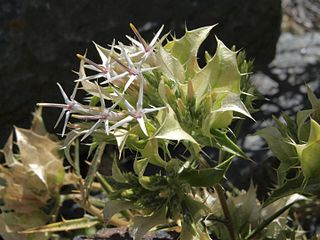
Hecastocleis is a genus of low thorny shrubs with stiff branches, assigned to the daisy family. At the tip of each of the branches, inflorescences are subtended by oval, thorny, whitish to greenish bracts that enclose several flower heads which each contain only one pinkish bud, opening into a white corolla. It contains but one species, Hecastocleis shockleyi, the only representative of the tribe Hecastocleideae, and of the subfamily Hecastocleidoideae. Its vernacular name is prickleleaf. It is confined to the southwestern United States.

Adenophyllum porophylloides is a species of flowering plant in the daisy family known by the common names San Felipe dogweed and San Felipe dyssodia. It is native to the Sonoran and Mojave Deserts of the southwestern United States and northwestern Mexico.
Antennaria argentea is a North American species of flowering plants in the daisy family known by the common name silver pussytoes or silvery everlasting. It is native primarily to Oregon and to northern and central California with additional populations in Nevada, Idaho, Montana, and Washington.
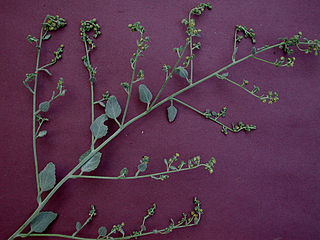
Dicoria (twinbugs) is a genus of North American flowering plants in the sunflower tribe within the daisy family, native to the southwestern United States and northwestern Mexico.
Lessingia tenuis is a species of flowering plant in the daisy family known by the common name spring lessingia. It is endemic to California, where it is known from the San Francisco Bay Area to Ventura County. It grows on the slopes of the California Coast Ranges in common local habitat such as chaparral.
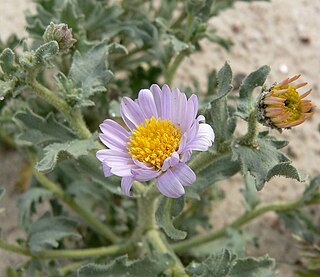
Arida arizonica,, is an annual plant in the, known by the common names arid tansyaster, desert tansyaster, and Silver Lake daisy. It is native to the very arid deserts of northern Mexico and the southwestern United States, and usually looks straggly and not very attractive. But in years with very heavy rainfall, it fills out and becomes rounded and bush like.

Gymnarrhena is a deviant genus of plants in the daisy family, with only one known species, Gymnarrhena micrantha. It is native to North Africa and the Middle East, as far east as Balochistan. Together with the very different Cavea tanguensis it constitutes the tribe Gymnarrheneae, and in the subfamily Gymnarrhenoideae.
Cavea is a low perennial herbaceous plant that is assigned to the daisy family. Cavea tanguensis is currently the only species assigned to this genus. It has a basal rosette of entire, slightly leathery leaves, and stems of 5–25 cm high, topped by bowl-shaped flower heads with many slender florets with long pappus and purplish corollas. The vernacular name in Chinese is 葶菊. It grows high in the mountains of China (Sichuan), Tibet, India (Sikkim), and Bhutan, and flowers in July and August.
Raillardella argentea is a species of flowering plant in the aster family known by the common name silky raillardella. It is native to the Sierra Nevada and nearby mountain ranges of California, its distribution extending east into Nevada and north along the Cascade Range and Klamath Mountains into Oregon. It grows in many types of dry, open mountain habitat. It is a rhizomatous perennial herb growing in a clump of rosetted basal leaves. The leaves are lance-shaped, up to 8 centimeters long, and coated in silky hairs. The plant produces an inflorescence up to about 15 centimeters tall consisting of a solitary flower head which is cylindrical to somewhat bell-shaped. The head is enclosed in the fused outer scales of the flowers, which look similar to the phyllaries of many other species' flower heads. The head contains many yellow disc florets up to a centimeter long each, and no ray florets. The fruit is a long, narrow achene which may be 2 centimeters in length including its plumelike pappus.

Cyclachaena xanthiifolia, known as giant sumpweed, or rag sumpweed is a North American plant species in the sunflower family, Asteraceae. It is the only species in the genus Cyclachaena. Giant sumpweed is believed to be native to the Great Plains but is now found across much of southern Canada and the contiguous United States, though rarely in the Southeast.

Ambrosia salsola, commonly called cheesebush, winged ragweed, burrobush, white burrobrush, and desert pearl, is a species of perennial shrub in the sunflower family native to deserts of the southwestern United States and northwestern Mexico.

Ambrosia monogyra, the singlewhorl burrobrush, is a North American species of plants in the sunflower family.

Felicia amoena is a variably hairy, sometimes glandular, biennial or perennial plant, of about 25 cm (10 in) high, that is assigned to the daisy family. It is somewhat woody at its base, roots at the nodes if these contact the soil, and has ascending branches. The leaves are oppositely arranged along the stems at and just above a branching fork, further up. The flower heads sit individually on up to 12 cm long stalks. They are 2–3 cm in diameter and consist of about twelve to twenty five heavenly blue ray florets that surround many yellow disc florets. Three subspecies have been recognised, that differ in width of the leaves and the involucral bracts, the size of the heads and number of ray florets and in having glandular hairs. These can be found in coastal sands and inland areas in the Western Cape and Eastern Cape provinces of South Africa. Flower heads can be found from June till October.

Felicia nordenstamii is a flowering shrub in the daisy family, Asteraceae. It is found only in South Africa where it grows on limestone hills close to the sea on the southern coast. Felicia nordenstamii is a many-branched shrub growing up to 30 cm (1 ft) tall. The lower parts of the stems are covered in grayish brown bark and the upper stem has many crowded, upwardly angled, alternate leaves with long hairs on the lower surfaces. Large flower heads form at the tips of the branches, each about 41⁄2 cm across, with about thirty purplish blue ray florets surrounding many yellow disc florets.
Felicia mossamedensis or yellow felicia is a well-branched, roughly hairy, annual or perennial plant of up to 30 cm (1 ft) high, assigned to the daisy family. It has alternately arranged, seated, flat to slightly succulent, broad-based, entire, blunt tipped leaves. The flower heads sit individually on top of a stalk of up to 8 cm (3 in) long, have an involucre of three whorls of bracts, many yellow ray florets and many yellow disk florets. It can be found in southern Africa, in Zimbabwe, Mozambique, Botswana, Swaziland, South Africa and on the coast of Angola.
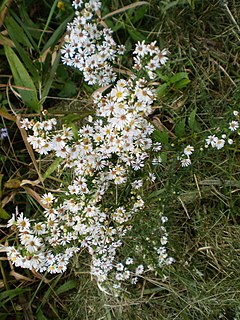
Symphyotrichum racemosum is a species of flowering plant native to parts of North America. It is known as smooth white oldfield aster, small white aster, and aster à grappes (French). It is a perennial, herbaceous plant in the family Asteraceae. It is a late-summer and fall blooming flower.
References
- ↑ SEINet Southwest Biiodiversity, Arizona Chapter, Dicoria argentea Strother includes photos + distribution map
- ↑ John L. Strother. 1982. Madroño, 9:101-103